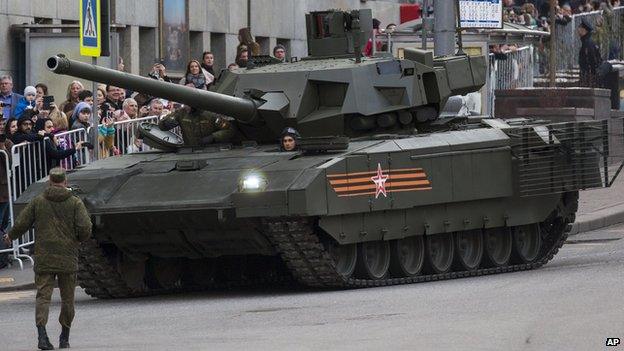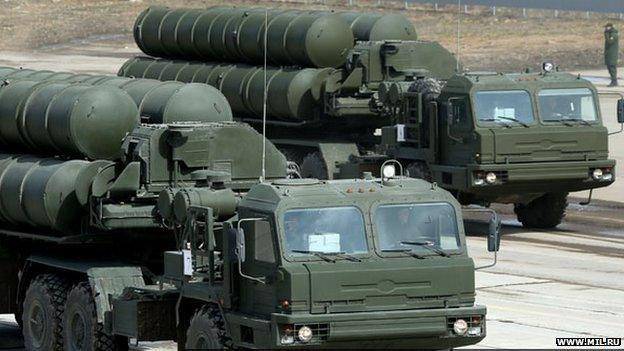Russia unveils new Armata tank for WW2 victory parade
- Published

The Armata T-14 is described as a highly flexible tank that will enter service in 2020
Russia has unveiled a new-generation battle tank called Armata T-14 ahead of World War Two Victory Day celebrations on 9 May.
It is among several new weapons systems featuring in a vast parade on 9 May. It is 70 years since the Soviet and Allied armies defeated Nazi Germany in 1945.
The Russian defence ministry has posted photos, external of the new military hardware, taken during a rehearsal.
Most Western leaders will not go to Moscow because of the Ukraine crisis.
Russia's former World War Two allies - the UK, France and US - will be conspicuously absent from the event. The Red Square spectacle is expected to be the biggest military parade ever held.

How big is the Moscow parade?

Serbian guards will be among the foreign troops marching in Red Square (pic: Serbian defence ministry)
15,000 Russian troops
1,300 foreign troops, including Serbian elite guards, Chinese guards of honour and Indian grenadiers
200 armoured vehicles
150 combat aircraft

'Fully robotic'
The Armata tank has an unmanned turret and a 125mm smooth-bore cannon that can fire guided missiles as well as shells.
The three-man crew has better protection than in existing Russian tanks. They will be housed in a reinforced chamber, away from the main gun, Russian media report.

Armatas rumbled through Moscow's streets during a parade rehearsal on 4 May
Zvezda TV, a Russian defence ministry channel, says the tank's chassis is adaptable as a platform for other weapons systems.
And Russia's RT news says the Armata could "evolve into a fully robotic battle vehicle".
Its computer technology, speed and manoeuvrability are said to be far superior to those of the T-90, the current mainstay of the Russian army.
Russia plans to bring in about 2,300 Armatas, starting in 2020, to replace Soviet-era tanks.

S-400 surface-to-air missile systems will be on show

The new RS-24 intercontinental ballistic missile will also be in Red Square
Foreign snub
Russia's annexation of Crimea and help for rebels in eastern Ukraine triggered Western sanctions, targeting senior government officials, defence industries and the energy sector.
What is Russia's army buying? - in 90 seconds
The Kremlin sent dozens of invitations to foreign leaders, but many will stay away from the 9 May parade.
Germany's Chancellor Angela Merkel will not be there for 9 May, but will visit the following day.
German Foreign Minister Frank-Walter Steinmeier plans to travel to Volgograd - formerly Stalingrad - on 7 May. Nazi troops were defeated there in one of the bloodiest battles in history.
Chinese and North Korean leaders will be among foreign dignitaries at the 9 May parade.
Serbia - a candidate for EU membership - sent an elite guards unit to Moscow on Monday. They will be among several foreign contingents in the march-past.
Greece's left-wing Prime Minister Alexis Tsipras plans to attend the parade.
- Published18 March 2015

- Published2 September 2014
